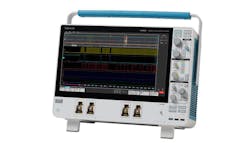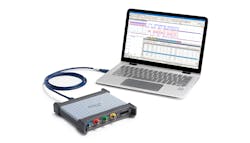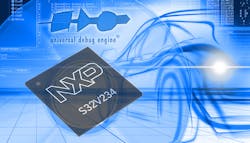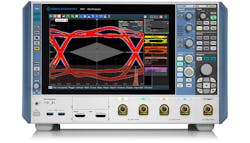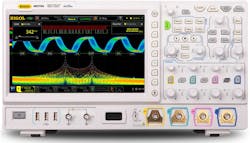Tektronix 6 Series MSO
The 6 Series MSO mixed signal oscilloscope from Tektronix extends the performance threshold of midrange oscilloscopes to 8 GHz and delivers a 25 GS/s sample rate simultaneously on all 4 channels, enabling up to four high-speed signals to be viewed at one time. The oscilloscope features low-noise inputs boosting measurement confidence especially at the highest sensitivity settings.
The device incorporates a new low-noise preamplifier ASIC, the TEK061, lowering noise significantly, especially on signals that are in the hundreds of millivolts peak-to-peak. The instrument delivers 16-bit resolution at 200 MHz when using the High Res mode. The highly upgradeable scope is available with a built-in arbitrary/ function generator, a free DVM and trigger frequency counter with product registration, and protocol options.
To improve connection to fast signals, Tektronix is also offering a new series of higher performance probes suited to the performance levels of the 6 Series MSO. The TDP7700 series of TriMode probes, offering bandwidths of 4, 6 or 8 GHz, enable single-ended, differential, and common mode signal measurements without moving or changing probes. Additionally, the TAP4000 and TDP4000 active, single-ended and differential probes now support up to 4 GHz bandwidth.
Pico Technology PicoScope 5000D Series FlexRes Oscilloscopes and MSOs
PicoScope 5000D Series FlexRes oscilloscopes and MSOs from Pico Technology features FlexRes hardware to employ multiple high-resolution ADCs at the input channels in different time-interleaved and parallel combinations to optimize either the sampling rate to 1 GS/s at 8 bits, the resolution to 16 bits at 62.5 MS/s, or other combinations in between.
The series provides 200 MHz bandwidth and adds 16 digital channels, providing the ability to accurately time-correlate analog and digital channels. The instruments feature waveform capture memory up to 512 megasamples, serial decoding and analysis, and a SuperSpeed USB 3.0 connection. A DeepMeasure tool, providing 12 parameters per cycle with the ability to display up to a million cycles, uses deep memory to analyze every cycle contained in each triggered waveform acquisition. PicoSDK supports continuous streaming to the host computer at rates up to 125 MS/s and utilizes an equation editor that allows the defining of complex waveform mathematical functions.
PicoScope 5000D Series oscilloscopes are priced from $1,155 / €979 / £809 for the 5242D 2-channel, 60 MHz model through to $3,025 / €2,575 / £2,125 for the top-of-the range 5444D 4-channel, 200 MHz mixed-signal model.
PLS UDE Testing and Debugging Environment
The UDE family of optimized testing and debugging tools for 64-bit processor platforms from PLS supports NXP’s S32V234 automotive multicore SoCs. The high-end controller, based on ARMv8-A, is equipped with four Cortex-A53 cores, a Cortex-M4 boot core and additional accelerator units. Designed specifically for ADAS image recognition and processing, the device is also equipped for other computation-intensive automotive applications.
Using hardware-based debugging functions, both the Cortex-A53 cores and the Cortex-M4 core of the S32V234 are accessible and controllable within a common, consistent UI. Multicore run control management allows the almost synchronous stoppage of either all or a user-defined set of the Cortex-A53 cores either manually or via breakpoints, whereby the Cortex-M4 boot core is always stopped due to the hardware. For shared code executed by multiple cores, the UDE provides multicore breakpoints, which always take effect regardless of which core is currently executing the code.
A combined target adapter is provided for the access devices of the UAD family, which enables the debug access to the various available S32V234 development boards. It ensures reliable and fast communication with the SoC via JTAG or the ARM-specific SWD interface. For rugged conditions, the adapter is optionally available with additional galvanic isolation.
Rohde & Schwarz RTP Family High-Performance Oscilloscopes
Rohde & Schwarz’ new high-performance RTP family (4, 6 and 8 GHz models) of oscilloscopes combine signal integrity with a high acquisition rate. In standard acquisition mode, the instrument can measure a million waveforms per second. Compensating transmission losses from the signal source to the oscilloscope (deembedding) in realtime, the oscilloscope is still extremely fast even with signal correction activated, and its digital trigger architecture can precisely trigger on compensated signals. Mask tests, histograms and frequency domain analyses can be performed at high speed for fast results with high statistical reliability. Sixteen logic channels, four voltage channels and four current measurement channels are available in addition to the analog oscilloscope channels. The product supports protocol analysis of serial bus interfaces and offers powerful spectrum and signal analysis functions.
Aimed particularly in the fields of aerospace and defense, automotive, industry and telecommunications, the instrument is suited for debugging electronic circuitries with different signals during development, including high-speed buses, multichannel RF interfaces, DDR memory interfaces, complex PMUs, and simple control and programming buses. The oscilloscope can test all applications where high-resolution signals need to be measured with a wide dynamic range and high sensitivity in the time and frequency domains.
RIGOL Technologies 7000 Series Digital Oscilloscopes
RIGOL Technologies’ latest line of digital oscilloscopes, the 7000 Series, offers a 10 GSa/sec sample rate, up to 500 M record length, and 20X oversampling on a 500 MHz signal. The core of the series is the company’s new UltraVision II architecture and its Phoenix chip-set. Two custom ASICs provide analog front end and signal processing performance. The high performance hardware design includes a Xilinx Zync-7000 SoC, dual core Arm-9, Linux +Qt, high speed DDR system memory and QDRII display memory. This architecture enables a high waveform capture rate of 600,000 wfms/sec, color graded intensity display, and improved time-base accuracy and jitter performance.
The series comes with a new user interface offering five ways to interact with the instrument: 10.1" display supporting responsive and intuitive touch navigation; native HDMI support to drive large displays and mouse control; touch enabled browser via tablet or smartphone; traditional knobs, buttons and soft keys; and UltraScope remote control and display software for a PC.
The instruments can be used as an oscilloscope, logic analyzer, protocol analyzer, waveform generator, digital voltmeter, or counter/totalizer. Analysis tools include: zone triggering, 41 precision measurements, multiple high-res color FFTs, as well as standard histogram and pass/fail analysis. The 7000 Series is available and shipping now in 8 Models (100, 200, 350 and 500 Mhz) with or without the logic analyzer. Pricing starts at $2,699.
